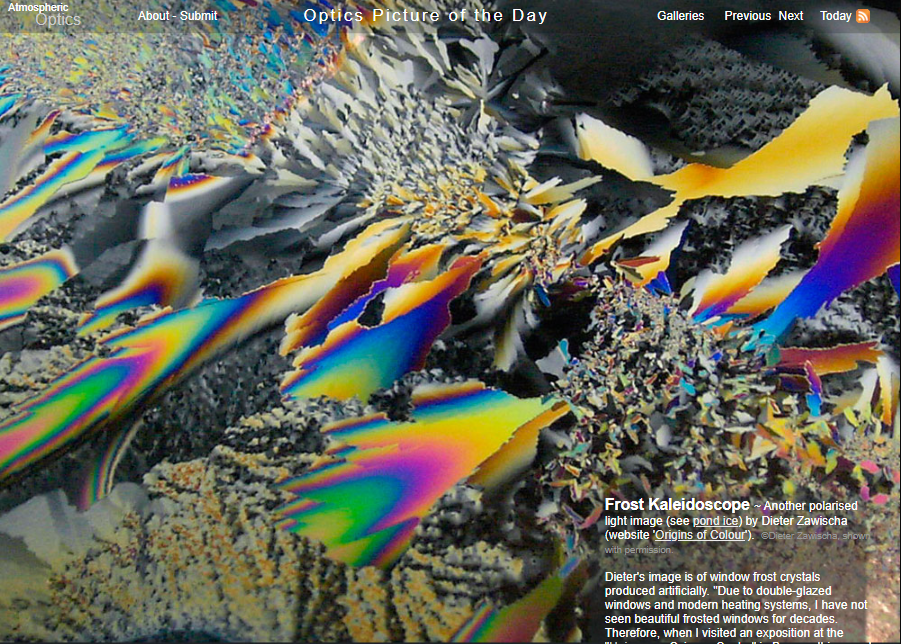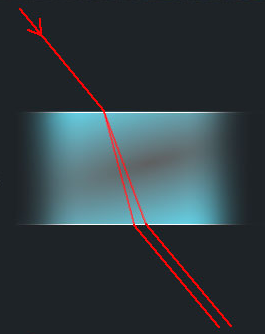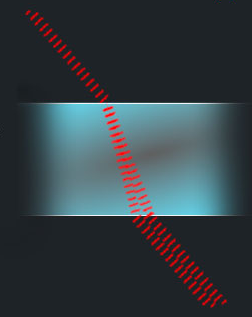Frost kaleidoscope
Frost Kaleidoscope: A Stunning Display of Polarized Light
When it comes to atmospheric optics, one phenomenon that never fails to captivate our imagination is the frost kaleidoscope. This mesmerizing display of colors and patterns is created by the interaction of polarized light with fern frost crystals on a chilled glass surface. While modern double-glazed windows and heating systems have made it rare to witness naturally formed frosted windows, artificial fern frost exhibits the same enchanting beauty.
The frost kaleidoscope image captured by Dieter Zawischa showcases the intricate details of window frost crystals produced artificially. These crystals, composed of large, flat single ice crystals, grow across the glass and meet in gentle curves, giving rise to their distinctive beauty. The image also highlights an interesting property of ice known as birefringence or double refraction.
Birefringence refers to the ability of a material to split light into two components with different polarizations. In Dieter's earlier image, this property was demonstrated through the use of polarizers. By placing the frosty glass between two polarizer sheets, the colors resulting from interference between the two birefringent rays were revealed. This phenomenon occurs due to the phase difference between the emerging waves, which is wavelength dependent and gives rise to the vibrant hues we observe.
Despite the prevalence of double-glazed windows in modern times, fern frost can still be found in certain instances. For example, car windshields or bodywork often exhibit this delicate formation. By using a polarizing filter and exploring different angles and lighting conditions, one can uncover the hidden colors within the frost. Experimentation with rotating the polarizer can also lead to changes in hues, confirming that birefringence is indeed responsible for this captivating optical display.
To fully appreciate the frost kaleidoscope phenomenon, it is essential to understand the underlying physics. Ice, being birefringent, splits the refracted ray into two components with different polarizations. These components then travel through the ice along paths of varying lengths, resulting in a phase difference between them. As the waves emerge from the ice and interfere with each other, the phase differences give rise to the spectral colors we observe.
The frost kaleidoscope not only serves as a visual spectacle but also offers a unique opportunity to explore the fascinating properties of light and ice. By delving deeper into this topic, we gain a greater appreciation for the intricacies of atmospheric optics and the wonders that nature has to offer. So, next time you come across a frost-covered surface, take a moment to witness the kaleidoscope of colors that lie beneath and marvel at the interplay between light and ice.
In conclusion, the frost kaleidoscope is a captivating phenomenon that showcases the beauty of polarized light interacting with fern frost crystals. Despite the rarity of naturally formed frosted windows, artificial fern frost provides a glimpse into this enchanting optical display. By understanding the principles of birefringence and interference, we can appreciate the vibrant colors and intricate patterns that emerge from the frost. So, keep an eye out for frost-covered surfaces and discover the hidden kaleidoscope of colors that await your exploration.

Frost Kaleidoscope ~ Another polarised light image (see pond ice) by Dieter Zawischa (website 'Origins of Colour'). ©Dieter Zawischa, shown with permission.
Dieter's image is of window frost crystals produced artificially. "Due to double-glazed windows and modern heating systems, I have not seen beautiful frosted windows for decades. Therefore, when I visited an exposition at the "Universum Science Centre" in Bremen this year, I was glad to see artificial fern frost on a cooled glass plate between polarisation filters, and I took some pictures."
Fern (or window) frost achieves its beauty from the large flat single crystals of ice that grow across the glass and meet in gentle curves. See earlier OPODs (1,2) for some images.
But - Ice is birefringent or double refracting as demonstrated in Dieter's earlier OPOD image.
Here, placing the frosty glass between two polarizer sheets has revealed the colours that result from interference between the two birefringent rays.
Fern frost still occurs even in these days of double glazing. Look on a car windscreen or bodywork for example. Use a polarising filter and experiment by viewing the frost at different angles both through the windscreen and by light reflected from it. There are likely to be positions where the colours are revealed. Once you see them, rotate the polariser - if birefringence is the culprit then the hues will change.
Good luck!

Rays through a fern frost crystal
Ice is birefringent and the refracted ray is split into two components with different polarisation.

The two emerging waves have a phase difference because their path lengths through the ice are not the same. The waves interfere. We see colours because the phase differences are wavelength dependent.
Note: this article has been automatically converted from the old site and may not appear as intended. You can find the original article here.
Reference Atmospheric Optics
If you use any of the definitions, information, or data presented on Atmospheric Optics, please copy the link or reference below to properly credit us as the reference source. Thank you!
-
<a href="https://atoptics.co.uk/blog/frost-kaleidoscope-2/">Frost kaleidoscope</a>
-
"Frost kaleidoscope". Atmospheric Optics. Accessed on April 25, 2024. https://atoptics.co.uk/blog/frost-kaleidoscope-2/.
-
"Frost kaleidoscope". Atmospheric Optics, https://atoptics.co.uk/blog/frost-kaleidoscope-2/. Accessed 25 April, 2024
-
Frost kaleidoscope. Atmospheric Optics. Retrieved from https://atoptics.co.uk/blog/frost-kaleidoscope-2/.